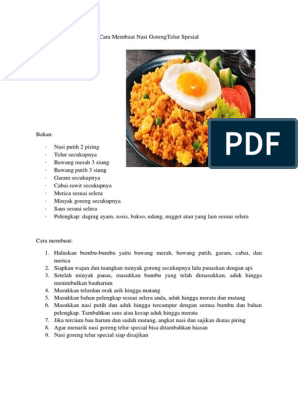
Crafting the Perfect Plate: A Deep Dive into Indonesian Nasi Goreng
Nasi Goreng, the Indonesian staple that transcends borders, is more than just fried rice. It’s a symphony of savory, sweet, and umami flavors, a culinary canvas where tradition meets personal expression. Mastering Nasi Goreng is not merely about throwing ingredients into a wok; it’s about understanding the nuances of Indonesian cuisine and the alchemy of achieving the perfect balance. This article will guide you through a detailed journey of creating authentic Nasi Goreng, ensuring a dish that’s both satisfying and reflective of Indonesia’s rich culinary heritage.
I. The Foundation: Selecting the Right Rice
The cornerstone of any exceptional Nasi Goreng is, undoubtedly, the rice. Forget freshly cooked rice; the ideal choice is day-old, refrigerated rice. This aging process allows the rice to dry out, preventing it from becoming mushy when stir-fried.
- Grain Matters: Opt for long-grain rice like Jasmine or Basmati. These varieties tend to separate well and maintain their individual integrity during the cooking process. Medium-grain rice can be used, but be mindful of its tendency to clump. Avoid short-grain rice, as it becomes too sticky.
- Preparation: Gently break up any clumps of rice with your fingers before you begin cooking. This ensures even distribution of flavors and prevents uneven cooking.
II. The Aromatic Symphony: Crafting the Spice Paste (Bumbu)
The soul of Nasi Goreng lies within its spice paste, or bumbu. This aromatic blend is the flavor foundation upon which the entire dish is built. While pre-made pastes exist, crafting your own offers unparalleled control over the final taste.
- Essential Ingredients:
- Shallots (Bawang Merah): Shallots provide a sweeter, more delicate onion flavor compared to yellow onions. Use approximately 6-8 shallots, finely sliced.
- Garlic (Bawang Putih): Garlic adds pungency and depth. Aim for 3-4 cloves, minced.
- Red Chilies (Cabai Merah): The heat level is entirely up to your preference. Use 1-2 large red chilies for a mild kick, or increase the quantity for a spicier experience. Remove the seeds for less heat.
- Candlenuts (Kemiri): Candlenuts act as a natural thickener and add a subtle creaminess to the bumbu. Use 3-4 candlenuts, lightly toasted to enhance their flavor. Note: Candlenuts are slightly toxic when raw, so always cook them.
- Shrimp Paste (Terasi/Belacan): This fermented shrimp paste is a crucial element, imparting a deep umami flavor that’s characteristic of Indonesian cuisine. Use about 1/2 teaspoon. If you are vegetarian, you can skip this ingredient.
- Palm Sugar (Gula Jawa): Palm sugar provides a caramel-like sweetness that balances the savory and spicy notes. Use approximately 1 teaspoon, grated. If unavailable, substitute with brown sugar.
- Ground White Pepper (Merica): White pepper has a sharper, earthier flavor than black pepper. Use a pinch to add a subtle bite.
- The Grinding Process:
- Traditional Method: The most authentic method involves using a mortar and pestle (cobek dan ulekan). This allows you to extract the essential oils and flavors from the ingredients, creating a more nuanced and complex bumbu.
- Modern Convenience: A food processor can be used for a quicker and easier process. Pulse the ingredients until a smooth paste forms.
- Sautéing the Bumbu:
- Heat 2 tablespoons of vegetable oil in a wok or large skillet over medium heat.
- Add the bumbu and sauté for 5-7 minutes, or until fragrant and the color deepens. Stir frequently to prevent burning. The bumbu is ready when the oil starts to separate from the paste.
III. The Supporting Cast: Proteins and Vegetables
Nasi Goreng is a versatile dish that welcomes a variety of proteins and vegetables. The choices are endless, allowing you to customize the dish to your liking.
- Protein Power:
- Chicken (Ayam): Diced chicken thigh is a popular choice. Marinate it in a mixture of soy sauce, garlic, and ginger for at least 30 minutes before cooking.
- Shrimp (Udang): Shrimp adds a delicate sweetness and briny flavor. Use medium-sized shrimp, peeled and deveined.
- Beef (Sapi): Thinly sliced beef sirloin or flank steak works well. Marinate it in a mixture of soy sauce, oyster sauce, and cornstarch for a tender texture.
- Egg (Telur): A fried egg is a classic accompaniment to Nasi Goreng. You can also scramble the egg and incorporate it into the fried rice.
- Tofu or Tempeh: For a vegetarian option, use diced and fried tofu or tempeh.
- Vegetable Variety:
- Carrots (Wortel): Diced carrots add a touch of sweetness and color.
- Green Beans (Buncis): Thinly sliced green beans provide a crisp texture.
- Cabbage (Kol): Shredded cabbage adds a subtle sweetness and crunch.
- Green Onions (Daun Bawang): Sliced green onions provide a fresh, oniony flavor.
- Peas (Kacang Polong): Frozen peas are a convenient and colorful addition.
IV. The Main Event: Stir-Frying the Nasi Goreng
Now, the moment you’ve been waiting for: bringing all the elements together in the wok.
- Heat and Oil:
- Ensure your wok or skillet is screaming hot. This is crucial for achieving that signature smoky flavor known as "wok hei."
- Add 2 tablespoons of vegetable oil to the wok.
- Cooking the Protein:
- If using meat, cook it first until browned and cooked through. Remove it from the wok and set aside.
- If using shrimp, cook it until pink and opaque. Remove it from the wok and set aside.
- If using egg, scramble it in the wok and set aside.
- Adding the Vegetables:
- Add the carrots, green beans, and cabbage to the wok and stir-fry for 2-3 minutes, or until slightly softened.
- Introducing the Rice:
- Add the day-old rice to the wok and break it up with a spatula.
- Stir-fry the rice for 2-3 minutes, until heated through.
- The Flavor Boosters:
- Soy Sauce (Kecap Manis): This sweet soy sauce is a quintessential ingredient in Nasi Goreng, providing sweetness, color, and depth of flavor. Add 2-3 tablespoons.
- Fish Sauce (Kecap Ikan): A dash of fish sauce adds a salty, umami flavor. Use sparingly, as it can be quite potent. A teaspoon is usually sufficient.
- Oyster Sauce (Saus Tiram): A small amount of oyster sauce can add a great depth of flavor. This ingredient is optional.
- The Final Stir-Fry:
- Return the cooked protein to the wok.
- Stir-fry all the ingredients together for 3-5 minutes, ensuring that the rice is evenly coated with the sauce and flavors.
- Taste and adjust seasonings as needed. Add more soy sauce for sweetness, fish sauce for saltiness, or chili flakes for heat.
V. The Finishing Touches: Garnishes and Accompaniments
Nasi Goreng is often served with a variety of garnishes and accompaniments, adding texture, flavor, and visual appeal.
- Essential Garnishes:
- Fried Egg (Telur Ceplok): A sunny-side-up fried egg is a classic topping.
- Pickled Cucumbers and Carrots (Acar): Acar provides a refreshing, tangy contrast to the rich flavors of the Nasi Goreng.
- Fried Shallots (Bawang Goreng): Crispy fried shallots add a crunchy texture and aromatic flavor.
- Krupuk (Crackers): Krupuk, Indonesian crackers, provide a satisfying crunch.
- Optional Accompaniments:
- Satay (Sate): Grilled meat skewers marinated in peanut sauce.
- Sambal: Indonesian chili sauce, for an extra kick.
VI. Variations and Personal Touches
Nasi Goreng is a dish that invites experimentation. Don’t be afraid to put your own spin on it.
- Nasi Goreng Kambing: A popular variation made with mutton or lamb.
- Nasi Goreng Seafood: Incorporate a variety of seafood, such as squid, prawns, and fish.
- Nasi Goreng Vegetarian: Use tofu, tempeh, or mushrooms as the protein source.
VII. Conclusion
Creating the perfect plate of Nasi Goreng is an art, a delicate balance of flavors and textures. By understanding the nuances of each ingredient and mastering the stir-frying technique, you can create a dish that’s both authentic and reflective of your own culinary creativity. Selamat makan! (Enjoy your meal!)












